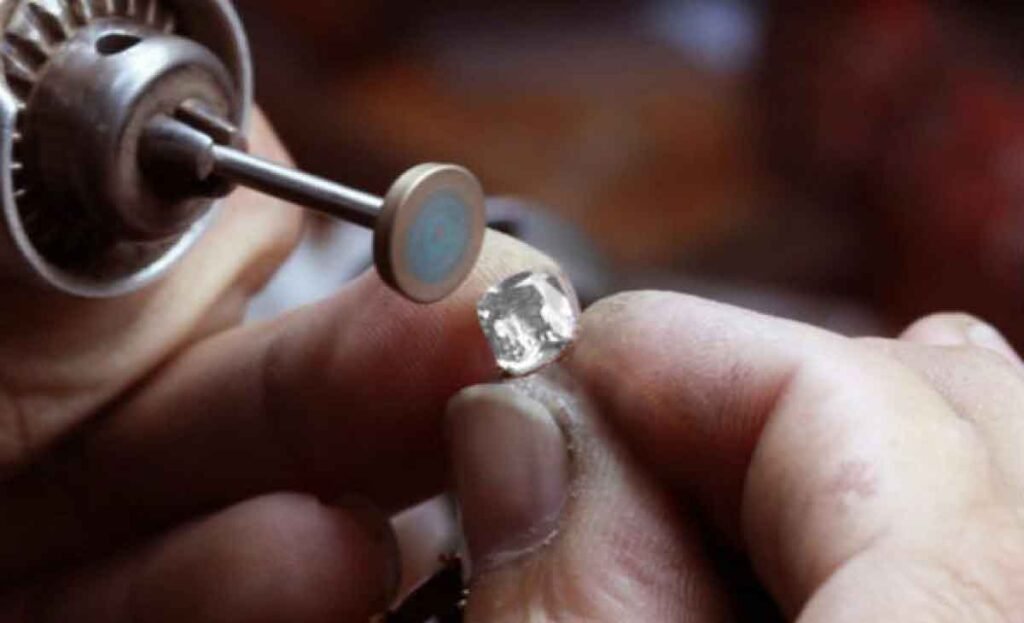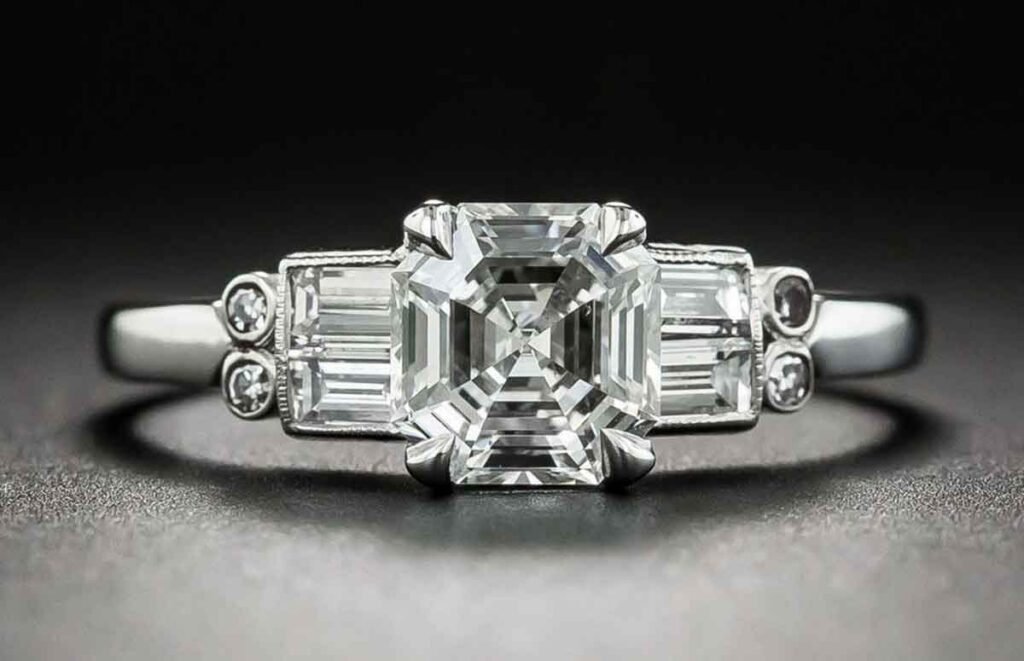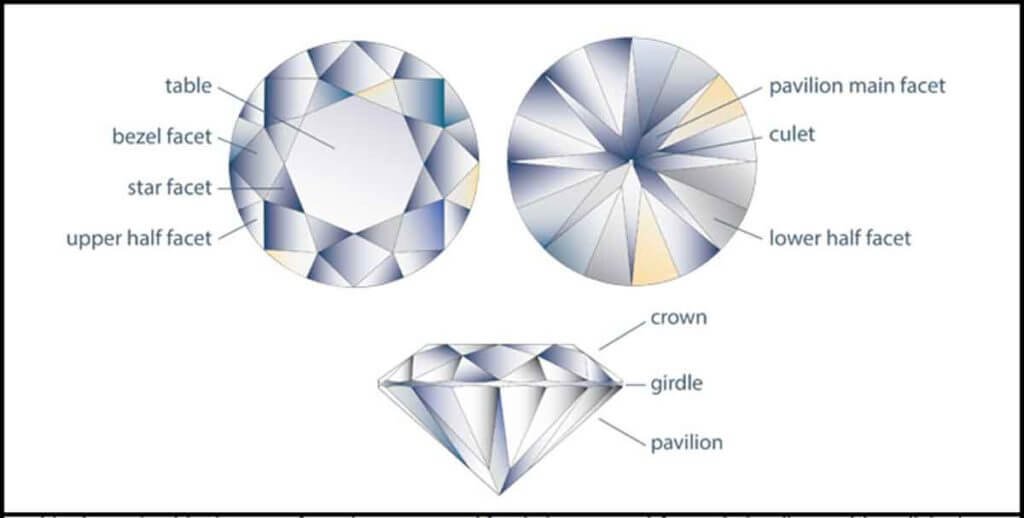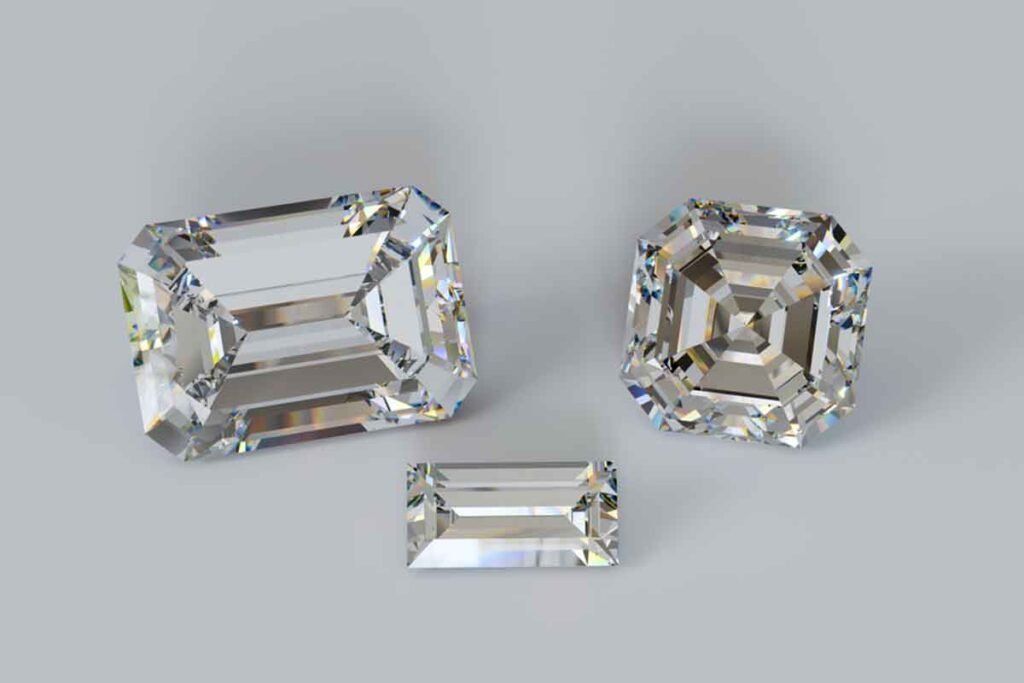How often have you heard your diamond-loving friends describe their priceless treasures in terms of carats, colors, shapes, and settings? Perhaps, too often they’ve become as familiar as your morning prayers. But seldom, if ever, do they describe them as brilliant or step-cut diamonds.
That’s understandable. These terms can only be found in the esoteric language of gem cutters and dealers.
Yet, it is necessary to know them because, among the 4Cs, cut eats a huge part of the price you paid for that twinkly little thing wrapped around your ring finger.
But before going any deeper, let’s get down to basics so you won’t drown in unintelligible information.
What is a Diamond Cut?

Diamond shaping and cutting are very interesting subjects. And for you to understand and appreciate them, it is better to go back to the time when diamonds first came into the scene. The timeline below, abridged as it is, is enough to paint a better picture.
- 1001 – 1100: diamonds were first found in India in loose and unpolished stones. Indians believed they possessed power and used them as talismans and charms to ward off evil. Towards the end of 1100, people started wearing them as jewelry items—but still in rough, uncut form.
- 1301 – 1400: superficial diamond cutting and polishing began. They were very crude, but enough to make the stone shine.
- 1400 – 1500: diamond shapes and cuts were introduced. The table cut emerged, followed by the step-cut. Emerald diamond came into being, which is the precursor of modern-day step-cut. It was also during this time when diamond dust was used to cut diamonds. Then in 1477, Mary of Burgundy became the first recipient of an engagement ring given to her by Archduke Maximilian of Austria. This event is considered to be the birth of the engagement ring.
- 1500 – 1700: tools were invented to cut facets into the diamond. This gave birth to the rose cut and transition cut. It was also in the period when European cutters started using the bruting tool to produce round diamonds. and improved faceting and polishing tools.
- 1801 – 1900 and onwards: tons of diamonds were found in Africa, making the supply of the stone more abundant than ever. It also ushered in more diamond shapes and cuts like the old-mine cut—the precursor of modern-day brilliant diamond cut.
The above illustrates the development of shapes and cuts. While current literature interchanges them more often than necessary, they are different yet, as inseparable as Siamese twins. Here’s why and how…
Diamond shape
This is the way a diamond is cut from the rough stone. Its purpose is to maximize a diamond’s brilliance; give character to the gem. A diamond’s shape is dictated by the size of the rough stone that lands on a gem cutter’s bench whose role is to preserve and maximize the stone’s carat weight. Examples of diamond shapes are Round, Princess, Cushion, Emerald, Oval, etc.
But “shape,” alone, doesn’t make a diamond glitter and sparkle if not cut in the right way. That takes us to the other side of the coin…
Diamond cut
This is a measure of how well a diamond is cut (faceted), polished, and proportioned; how good are its depth, polish, and symmetry. Diamond cut is a tight play between brilliance and the price of the finished jewelry item.
It is the most important factor in determining a diamond’s value and price. Of the 4Cs, cut is a major determinant of the price of a diamond jewelry item.
Cut quality is determined by several elements like proportion, facets, finishing details, and its ability to reflect light.
The GIA (Gemological Institute of America) evaluates cut by looking at:
- How the diamond appears when viewed face-up, based on the attributes of brightness, fire, and scintillation.
- How well the diamond was designed to ensure durability and optimal weight.
- The quality of workmanship or craftsmanship that went into aligning and polishing the diamond’s facets.
Currently, gems in the market are either brilliant cut or step-cut diamonds. And you will find their differences as you read through this article.
What is a Step-cut Diamond
A step-cut diamond is a diamond that is either square or rectangular in shape, with parallel lines (facets), that run down along its sides. This diamond cut got into the mainstream during the Art Deco period (also called “style moderne”)—a movement in the decorative arts and architecture that emerged in the 1920s, evolving into a major style in Western Europe and the United States in the 1930s.
And “what does step-cut mean?” The term step-cut was derived from the fact that if the diamond is viewed face-up, the facet arrangement would look like steps. This cut is known to give a diamond unparalleled beauty.
A step-cut, however, does not appeal to all 10 diamond shapes in the market, except the following:
Emerald diamonds
Emerald cut diamonds are one of the oldest diamond cut, dating back to the 1500s when gem cutters initially created the shape from emerald stones. Today, women all over the world admire its sleek and clean look.
It is rectangular in shape, with eight sides (the corners of the stone are clipped creating smaller sides). The long, rectangular facets create an “hours mirrors” effect making it look as if going on and on.
Emerald cut diamonds are great for engagement rings because of their timeless look. They are known for their elegance and shine. Though they don’t sparkle like a brilliant-cut diamond, yet they still exhibit stunning beauty. An emerald diamond would look great on a step-cut ring.

They are the most popular step-cut diamonds and were given a huge boost when Kate Middleton was gifted with one from Prince William.
Asscher Diamonds
Many diamond shapes derive their name from what they look like, e.g., round, oval, pear, or heart. Except for the Asscher cut diamonds. It was invented in 1902 by Joseph Asscher. a legendary diamond cutter and founder of the IJ Asscher Diamond Company which still stands today.
To protect his invention from being copied, he applied a patent for it, which remained active until WWII.
The Asscher cut diamond is square-shaped with 72 facets (three rows on the top and another three rows on the bottom) that are larger and wider-set. This arrangement draws your attention to the center of the stone with its captivating and mesmerizing flashes of color.
One of the most famous Asscher diamonds of all time was the Krupp Diamond—a jaw-dropping giant at 33.19 carats worn by Elizabeth Taylor.
Baguette Diamonds

This gem got its name from a French word meaning “a long, and thin loaf of bread.” Which is what a baguette looks like—a long, rectangular-shaped diamond cut.
It differs from the emerald and the Asscher cuts due to its sharper and more pronounced corners. It has only 14 facets, making precision very important to give a good quality cut.
The steep cuts in a baguette don’t allow for a lot of sparkles, but they reflect light in a hologram-like way.
More often than not, baguettes are not used for center stones but as side-stones in three-stone engagement rings.
Carre Diamonds
Carre diamond is square-shaped and is intended to maximize the use of rough diamonds, and minimize waste during cutting.
While its sharp 90-degree corners maximize its table size, they are also prone to chipping when caught on a hard object. To prevent this, Carre diamonds are mounted on a halo or bezel setting.
Carre cut diamonds don’t sparkle but it displays very good fire, especially when viewed in natural light. And because of its wide face, inclusions, and any color tint is more obvious compared to other step-cut diamonds. Hence, when shopping for a Carre, make sure there are no visible inclusions.
Though the Carre is the least popular among step-cut diamonds, it should not be completely ruled out in your jewelry collection. Its facets and its square shape would make it look like a pyramid when viewed from the top.
Now let’s go to its closest rival in the diamond engagement ring business, the brilliant-cut.
What is a Brilliant-cut Diamond
Understanding brilliant-cut diamonds require a basic knowledge of the parts of a gem.

Brilliant cut diamonds, such as the ones in this Pompeii3 review, today look quite different from the days when diamonds were first discovered in Africa in the early 20th century. Thanks to newer technology and tools, much experimentation, and the 1919 hypothesis of diamond expert Marcel Tolkowsky, brilliant diamonds today are really brilliant.
According to Marcel, a brilliant-cut diamond must act as a system of mirrors and windows. And to achieve that effect, the table must be so mathematically designed to capture light as much as possible. This will allow light to enter the diamond through the top and exit back through the top to maximize the gem’s fire, brilliance, and scintillation.
In addition to that, a diamond must have 57 facets (58 if polished with a culet). The crown must have one table facet, 8 bezel facets, 8 star facets, and 16 upper girdle facets, and a culet.
The pavilion, crown, and table must be in right proportion with each other. If the table is too small, not enough light will reflect from the stone. If large, too much light will escape from the diamond. The pavilion cannot be too deep or too shallow, otherwise, the light will be lost in the bottom, resulting in less brilliance.
The brilliant cut is intended to draw out the most and best of a diamond’s sparkle. For this reason, brilliant diamonds are often used for round cut and princess cut engagement rings.
Now that you know the difference between the two, you are faced with a dilemma: step-cut or brilliant?
Step-cut vs. Brilliant cut
The answer to this depends on what matters to you most—sparkle or price.
Since there is minimal work and material waste, step-cut diamonds are cheaper than the brilliant-cut. But it sparkles less since they have lesser facets. But you cannot rule them out completely. The step-cut has a sleek look that appeals to fans of vintage jewelry and those inclined to minimalist-style fashion.
And, thanks to Kate Middleton and Lady Gaga who flashed emerald-cut engagement rings, it is staging a strong come-back.
If sparkle, lots of it, is your priority, then a brilliant-cut diamond is the thing for you. Since it has more facets, it exhibits more sparkle and fire. But it costs a fortune. In fact, if you ask “what diamond cut is most expensive?” Without any doubt, the answer is brilliant cut.
But are step-cut and brilliant diamonds all the choices you have? Fortunately, no. You can browse through old-cut diamonds.
What are old-cut Diamonds

They are called old-cut diamonds because they were cut long before the advent of precision diamond-cutting tools. Old-cut diamonds were the mainstay of the diamond jewelry business from the early 18th century to the late 19th century.
This type of cut is also called the “old-European cut,” or the “Victorian cut.” Due to the lack of precision tools, they appear thicker compared to modern diamonds. And since the art of faceting then has not reached its current levels, they sparkle less.
Old cut diamonds are popular among people who love or collect vintage jewelry. And many Victorian-era pieces of jewelry have charming styles.
Are old cut diamonds worth more?
Not necessarily. The price of a diamond, any diamond for that matter, follows the requirements of the 4Cs. On certain occasions, the price of an old-cut diamond can be astronomically high due to the story behind the gem, like that of the Darya-i-Nur.
Step-cut diamonds gained entry into the diamond jewelry world during the Art Deco period (between 1920 to 1930). Yet despite their old origins, they have not lost their charm of getting the attention of people shopping for engagement rings. They possess a certain degree of striking beauty and style.
Their sleek looks appeal to fans of vintage jewelry and those leaning towards minimalism. And because a step-cut preserves more of a stone’s carat weight, it costs less. They may not sparkle more than a brilliant-cut diamond, but they provide a better showcase for a diamond’s clarity.
And that’s about it. We hope that you have learned more about step-cut diamonds and are ready to make that purchase. Now, if you want to know about other diamond cuts, check out our article, “Choose Your Cut: Comparing Emerald Cut vs Radiant Cut Diamonds.”
